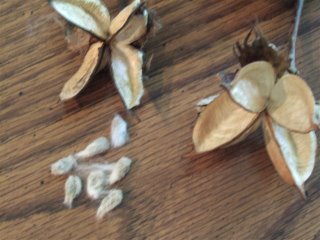I got some interesting emails from my Dad this morning. There is a cotton field across the street from his house and a while back he was showing it to my Uncle during a visit. (My Uncle grew up in Iran.) Just a few days ago, Dad took photographs of the cotton as it neared harvest.
Dad, being an agronomist, knows quite a bit about growing crops in Georgia. He grew corn, soybeans, sorghum and other varieties for research in south Georgia for thirty plus years. Plus, as you'll read below, he has a rather intimate relationship with growing and picking cotton.
I found the photographs and the accompanying explanations very interesting and a slice of history and life. I hope you enjoy it. (The rest of the text is written by Dad and taken from his emails.)
*****
I am sending some pictures and will try to explain something about what is seen in the pictures.
This first picture shows several bowls (this is the roundish growth) that have split open and is ready to harvest.
This picture shows a fully opened bowl with cotton locks hanging out. Hard rains can beat the cotton out of the open bowls, so it is important to get the crop harvested before a big rain occurs. Fortunately, September & October are very dry months, making for good harvest weather.
This picture shows a view of the entire field approaching harvest time. You can't see from this view, but about half of the bowls have cracked open and about half are yet to open. The farmers sprayed a chemical over the field about 2 weeks ago that causes the leaves to dry and fall off and promotes the cracking and opening of the bowls.
This is a view of two open bowls with cotton removed. A bowl with cotton still intact is in the background. The bowls with the cotton removed are called burs. The points are quite sharp and can hurt your hands, if one had to harvest by hand. Of course, they have large "cotton pickers" (machines) that remove the cotton and partially clean it, removing leaves and field trash.

Shows close-up of components of mature cotton bowl. Cotton removed (referred to as "lint"), burs with cotton removed and small cotton seed. I pulled these out of the lint by hand so you could see them. Normally you do not see these in the field. The seed will removed by a machine referred to as a "cotton gin." It is a place where the farmers takes his cotton crop for sale. The company who buys the crop dumps large loads into a large machine called a gin which separates the lint from the seed. The lint is baled in large bales what weighs about 500 pounds each. It remains in these bales until it is sold to a company that would make cotton thread of differing sizes, which is then used to make cloth material or other products. The seed would be "cleaned" to remove the fuzzy lint that remains after the ginning process. This cleaned seed could be used to plant the crop next year or used to make "cotton meal," an excellent source of plant protein used in animal feed, including pet foods.

Another view of a plant with several open bowls ready to harvest. The farmer has to wait until about 99% of the bowls are open and ready to harvest, so you have bowls in various stages of being "open" or ready to harvest. Heavy, prolonged rains during this waiting period can cause lots of damage since some of the cotton can be knocked to the ground by rains and strong winds and would be rendered useless to the farmer. Or it can begin to sprout (germinate) in the open bowls, again making it useless. This field was grown without irrigation and limited rainfall, so it is not a great field of cotton. You can't see it from these pictures, but there are many small bowls that are about half mature and are partially open. These are not worth much to the farmer since it reduces his overall yield potential.
Close- up view of a beautiful, open bowl, ready for harvest. It would be excellent if all of them looked like this.
Another close-up view of a beautiful bowl open and ready to harvest. If one picked by hand. like I did as a child, you would love to find a field like this. You can quickly remove the lint from the burs and move along to the next plant. It took lots of hard work to pick 200 pounds a day. Farmers only paid about 4-5 cents/pound so you had to work extremely hard to make $8-10/day when I was about 10-12 years old. I recall coming home from school in the fall and heading for the cotton patch. I might get 15-20 pounds picked before it was time to head for the house and feed hogs. chickens, or milk cows before dark.. Oh, the good ole days.

Get your sack, the long tube-like sack that we pulled along behind us and held the hand-picked cotton, and meet me in the cotton pitch. It was kind of fun in ways. I recall several very serious talks with my mom as we worked along beside each other, picking cotton and discussing the meaning of living a good life, working hard, being honest, loving God and neighbor, so it was more than just picking cotton. Guess we miss some of that closeness these days.










1 comment:
Dave,
Thanks for the post - I really enjoyed it and I like what Dad wrote. His memories triggered many memories of mine from the corn field. Between your last 2 posts you are KILLIN' me with nostalgia. But in a good way.
-MM
Post a Comment